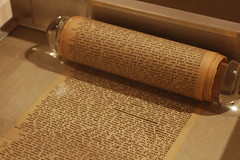“Copyfraud” and Google Books
By Kristopher A. Nelson
in
June 2009
900 words / 4 min.
Tweet
Share
The Register and Slashdot have picked up a theme from a 2006 law review article by Jason Mazzone on “copyfraud,” extending the idea to explain a new incarnation of it emerging in relation to Google Books.
Please note that this post is from 2009. Evaluate with care and in light of later events.
 The Register and Slashdot have picked up a theme from a 2006 law review article by Jason Mazzone on “copyfraud,” extending the idea to explain a new incarnation of it emerging in relation to Google Books. Mazzone wrote:
The Register and Slashdot have picked up a theme from a 2006 law review article by Jason Mazzone on “copyfraud,” extending the idea to explain a new incarnation of it emerging in relation to Google Books. Mazzone wrote:
Copyfraud is everywhere. False copyright notices appear on modern reprints of Shakespeare’s plays, Beethoven’s piano scores, greeting card versions of Monet’s Water Lilies, and even the U.S. Constitution. Archives claim blanket copyright in everything in their collections. Vendors of microfilmed versions of historical newspapers assert copyright ownership. These false copyright claims, which are often accompanied by threatened litigation for reproducing a work without the owner’s permission, result in users seeking licenses and paying fees to reproduce works that are free for everyone to use.
The article on the Register describes a newer player in this scheme: Google Books.
Kessinger [a publisher] made the [public domain] document useless to scholars, to force them to purchase the full hardcopy edition for $25. Links on the Google Books page directed purchasers to the Kessinger edition on Amazon.com and other online booksellers. Scholars were outraged. These works are clearly in the public domain, dating back to the 1890s and beyond.
When questioned, Google said it “must err on the side of caution… until we have determined that the book has entered the public domain.” But with the sheer volume of ebooks being submitted by outside publishers, there are obvious delays in clearing rights. Some publishers have exploited this gap, providing copyfraud editions where no free edition was available.
via Copyfraud: Poisining the public domain from The Register.
Legally, though frustrating, the situation is not always quite as clear cut a case of “stealing” from the public domain and “defrauding” the general public. Certainly, the process outlined in the Register article is essentialy that:
Committing copyfraud is astonishingly easy and costs nothing. I can borrow a public domain book from any library and scan it, or I could download the text from Project Gutenberg. I reformat it as a PDF, mark it with a copyright date, register it as a new book with an ISBN, then submit it to Amazon.com for sale. I may not even need to print and bind any books, I can offer it through Amazon’s Booksurge print-on-demand service, or as an ebook on Kindle. Once the book is listed for sale, I can submit it to Google Books for inclusion in its index. I could easily publish thousands of books; most would never sell, but with zero up-front cost, any sale is pure profit.
The key part of the above scheme is the scanning or copying of text directly, adding nothing new (or very little new, anyway – not enough to establish a copyright anyway). With no new value added (in loose terms – copyright is more complicated than this), there is no “new” work at all. Thus, there is no valid copyright. I can still sell these works, of course, but Google should not deny full access to them.
Re-typesetting a book (and possibly editing it, fixing errors, and generally adding value) is a different story. If a publisher does enough new to the book, it’s very possible that doing so would generate a copyright on the newly typeset book – but still not on the text itself. That would remain in the public domain, free to be typeset by someone else, quoted from at any length, or otherwise shared. But copyright – at least in a “thin” form – would, I believe, likely protect against straight-up photocopying or scanning of the newly published book itself, and that would then likely include that particular edition in Google Books as well.
“Thin copyright” covers works that, for example, add only limited additional value to a public domain work. The Electronic Frontier Foundation explains:
[W]here copyright owners have a thin copyright – for instance, where they choose to release a compilation DVD with a public domain work bundled with works in which they do hold the copyright. In either case, the copyright owner would obtain, at best, a thin copyright in the non- public domain elements, but does not thereby obtain copyright in an uncopyrightable public domain work. As recognized by numerous cases, including the Supreme Court’s decisions in Harper & Row v. Nation Enterprises [471 US 539 (1981)] and Feist Publications, Inc. v. Rural Telephone Service Co., 499 U.S. 345 (1991), and the Ninth Circuit’s decision in Sega v. Accolade, the public continues to retain the right to access the uncopyrightable parts of the compilation. An exemption is required to allow consumers to exercise their right of access and to prevent copyright owners from using technological protection measures as a bootstrap to extend their thin copyrights over public domain works.
Remember: the law is pretty much always more complicated than it appears at first glance!
Related articles by Zemanta
- Does Copyright Foster or Hinder Innovation? (inpropriapersona.com)
- Random House disabling Kindle speech (inpropriapersona.com)
